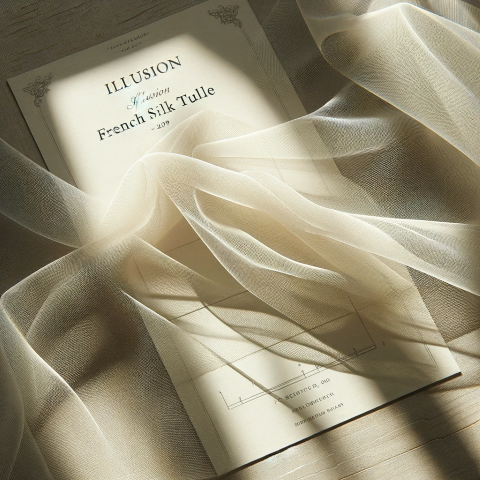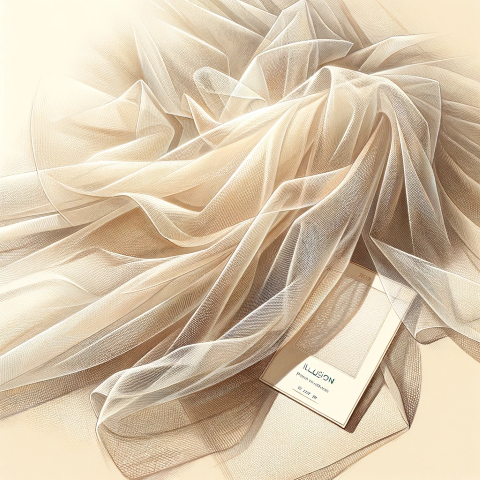Last Updated on: 03-Apr-2024 (3 months, 24 days ago)
Share on Facebook • Share on Twitter
Illusion in Textiles: The Delicate Dance of French Silk Tulle
Illusion in Textiles: The Ephemeral Artistry of French Silk Tulle
In the fascinating realm of textiles, the term 'Illusion' conjures visions of ethereal beauty and delicate artistry. Predominantly referring to a very fine, all-silk tulle, this fabric whispers tales from French ateliers, encapsulating centuries of craftsmanship. With its cobweb-like appearance and hexagonal open mesh, Illusion is a testament to the intricacies possible in textile creation.
Emerging from the sophisticated corridors of French fashion and textile innovation, Illusion's lineage is rich and storied. Historically, France has been at the forefront of luxury textile production, with its artisans and craftsmen meticulously creating fabrics that epitomize elegance. Illusion, with its delicate nature and almost ephemeral quality, became a favorite amongst couturiers and designers looking to add a touch of whimsy and delicacy to their creations. The fabric, although appearing fragile, is a culmination of precise weaving techniques and the unmatched quality of silk threads used.
- Classic Illusion: Traditionally crafted using pure silk, it boasts a consistent hexagonal mesh and a soft drape, perfect for veils and overlays.
- Embroidered Illusion: Embellished with intricate patterns, be it floral motifs or geometric designs, offering an additional layer of depth and luxury.
- Sequined Illusion: Adorned with sequins, either scattered or patterned, it captures light and adds a touch of shimmer.
- Metallic Illusion: Incorporates metallic threads or finishes that give a subtle sheen, elevating its ethereal appearance.
- Colored Illusion: While traditionally in softer hues, advancements in dyeing techniques have introduced Illusion in a spectrum of colors, from pastels to deeper tones.
Profiles of Major International Manufacturers or Users
- Chanel: This iconic French fashion house has often incorporated Illusion in its haute couture collections, using its delicate nature to create timeless pieces.
- Dior: Known for its romantic and avant-garde designs, Dior frequently employs Illusion to craft ethereal dresses and gowns that grace global runways.
- Elie Saab: A maestro of evening wear, Saab's designs often feature Illusion with intricate embroidery, making his creations a favorite amongst the global elite.
- Givenchy: This luxury French brand seamlessly merges tradition with modernity, often choosing Illusion for its vintage-inspired modern collections.
- Vera Wang: Synonymous with bridal fashion, Wang's gowns frequently showcase layers of Illusion, creating a dreamy and romantic aura for brides worldwide.
- Wedding Veils: Illusion's ethereal quality makes it a top choice for crafting wedding veils that complement a bride's ensemble.
- Evening Gowns: Designers adore the fabric's ability to add depth, layering, and movement to gowns, making them stand out on the red carpet.
- Lingerie: The transparency and softness of Illusion lend a touch of luxury and sensuality to lingerie pieces.
- Theatrical Costumes: Illusion's lightweight and flowy nature makes it ideal for theatrical costumes, especially for characters meant to depict ethereal beings or fantasy elements.
- Accessories: From scarves to gloves, the fabric's versatility allows for a range of accessories that are both functional and fashionable.
The world of textiles is filled with wonders, and Illusion, in its delicate beauty, stands out as a fabric that seamlessly weaves history, luxury, and craftsmanship. From the historic ateliers of France to modern runways and bridal aisles across the world, its ethereal charm remains unmatched. In understanding Illusion's nuances, one gains a deeper appreciation for the artisans and designers who transform mere threads into pieces of art. As the textile industry evolves with technology and changing tastes, the timeless appeal of Illusion ensures its continued presence in the tapestry of fashion and design.
A very fine, all-silk tulle which originated in France. It has a cobweb appearance. Hexagonal open mesh. Made in 52 inch and 72 inch widths. Used in veils, particularly for weddings, trimmings. incarnadine having the pinkish color of flesh; red, especially bloodred.
Some more terms:
Taffetta
Basic plain weave that is crisp and smooth on both sides, usually with a sheen. Warp and filling approximately of the same count. May be plain, printed, striped, checked, plaid, or antique with...
Read about TaffettaAir Permeability
The permeablity, or the ease with which air passes through material. Air porous ness determines such factors as the wind resistance of sailcloth, the air resistance of parachute cloth, and the...
Read about Air PermeabilityBar Code
The Universal Product Code (UPC) symbol that contains readable optical recognition characters that can be read by a scanner to monitor merchandise at point of sale. The symbol utilizes ten-digit...
Read about Bar CodeFrame
Basic internal structure or skeleton of an upholstered piece. Kiln-dried hardwood is best for durability in wooden frames, but often engineered wood products are used. Metals are also used in marine...
Read about FrameAger
Ager is a substance used in the textile industry to enhance the dyeing process by creating a uniform color. It is a mordant, which means that it helps fix the dye onto the fabric and improves...
Read about AgerJohnny Collar Trends: Stylish Options for Men and Women
Johnny collar is a style of collar commonly used in clothing, especially in polo shirts and other casual tops. It is a type of collar that does not have a fold-over design and has a V-neckline. This...
Read about Johnny collarOverdyed
In textile terminology, "overdyed" refers to a dyeing process where a previously dyed fabric or garment is subjected to another round of dyeing using a different color. This technique is employed to...
Read about OverdyedFolded yarn
Folded yarn, also known as cabled yarn, is a type of yarn that is created by twisting two or more plies of yarn together in the opposite direction from which they were spun. This process, called...
Read about Folded yarnOn this page
Add a definition
- The term you want to define
- Its definition in 500 words or less
- Attach an image if necessary.
- Optionally, tell us about yourself in 200 words or less!
Companies for Illusion:
- Company name
- Company address
- Attach a logo, if necessary.
- Optionally, tell us about yourself in 200 words or less!

 The Indian textile industry is known for its high quality and competitive pricing.
The Indian textile industry is known for its high quality and competitive pricing.

